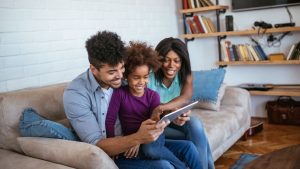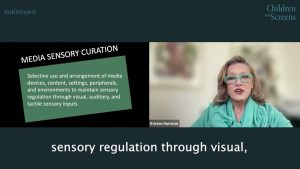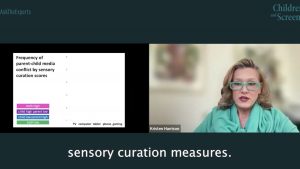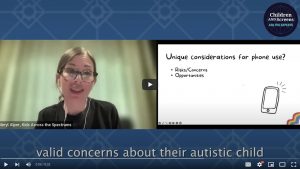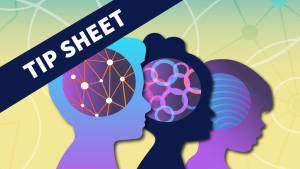
Parenting neurodivergent youth and their use of digital media comes with a unique set of considerations that influence family rules and dynamics. What might parents and caregivers want to know to promote safety, accommodate sensory processing differences, and minimize family conflict? How can parents encourage and support healthy digital media use by their neurodivergent children?
On This Page
Neurodivergent Youth and Media Use: What to Know
Media Use is Similar but Different
How neurodivergent children and adolescents engage with technology is both alike and unlike media use among neurotypical kids, says Meryl Alper, PhD, Associate Professor of Communication Studies at Northeastern University.
-
- What’s similar? Boys on the autism spectrum and with ADHD primarily spend their media time with friends on video games, much like neurotypical boys. Girls on the spectrum report that online friendships are easier to make, much as neurotypical girls do.
- What’s different? Alper says autistic adolescents report using social media more for entertainment than friendship building. Neurodivergent children are also at increased risk for bullying and cyberbullying compared to neurotypical youth. The emotional burden from this victimization can compound difficulties with mental health. Neurodivergent girls report high rates of general social anxiety, which can spill over into their online world.
Unique Challenges to Media Use and Social Communication
“In their everyday lives, neurodivergent kids may encounter a number of challenges that impact when, where, why, and in what manner they use media,” says Alper.
Social interaction and behavioral challenges for neurodivergent youth may include:
-
- Engaging in back-and-forth conversation
- Understanding emotional intention
- Understanding non-verbal communication
- Expressing themselves with language
- Planning and executive function skills
- Handling changes to routines
- Transitioning between activities
- Managing sensory input sensitivities
Unique Strengths and Interests Affect Media Use
It’s not all a struggle, says Alper, who notes that neurodivergent children can have unique strengths and sources of pleasure that inform their media use and consumption. These can include:
-
- Hyperlexia (able to read at an early age)
- Strong visual pattern recognition
- Attention to detail
- Rote memory
- Alternative problem solving
- A strong sense of justice and fairness
Increased Risk of Cyberbullying – As Victim and Perpetrator
Neurodivergent youth are at increased risk of being a victim of cyberbullying, but like neurotypical peers, they may not represent bullying they experience online in those terms. “Cyberbullying is really not what teens call it,” says Abigail Phillips, MLIS, SLIS, PhD, Assistant Professor, School of Information Studies, University of Wisconsin-Milwaukee. Youth may refer to these experiences as“drama,” “just teasing,” or “just a bad day.”
Less talked about, says Phillips, is that the same traits that make neurodivergent youth at risk for cyberbullying victimization, like social disinhibition, difficulty with social and nonverbal cues, and how they may engage in group dynamics, may lead them to perpetrate cyberbullying themselves without realizing the negative emotions they may be causing others to feel.
This underscores a particular need to teach digital citizenship, both broadly and to neurodivergent youth, says Phillips. “We should start educating youth about ethical, responsible, and positive online behaviors and to be responsible users and creators of online content.”
Tips: Considerations for Assessing Media Use by Neurodivergent Youth
Evaluate Media Use in Context
Assess the benefits and harms of your neurodivergent child’s media use with close observation of the individual child’s use patterns, says Kristen Harrison, PhD, Richard Cole Eminent Professor, Hussman School of Journalism and Media, University of North Carolina. Harrison recommends asking these questions about the media use:
-
- Why is the child using this content?
- What are they getting out of it?
- How do they feel and act after they walk away – are they agitated or showing signs of a problem?
“If you’re seeing signs of agitation or some kind of problem, that’s something to investigate,” says Harrison. On the flip side, “if the screens are helping them feel composed, then think of that media as one tool to help with regulation and learning – but also keep encouraging some other tools and other environments so they have a choice.”
Consider Digital Media’s Potential for Sensory Curation
For neurodivergent use with sensory sensitivities, “media can reduce the discomfort of dysregulating environments – those that are too intense or, conversely, boring,” says Harrison. Media use may allow for self-soothing and reduce anxiety. “Remember that adults decide where children eat, sleep, learn, and play. The ability to use media devices as tools to manage sensory input should be especially appealing to people for whom the built environment was not normed, like kids whose neurodivergence involves sensory challenges.”
Watch for Unique Learning Opportunities
Media use may provide alternative and beneficial paths to learning for neurodivergent youth with specific disabilities, says Harrison. “I’ve always wrung my hands over the fact that my daughter, who has a language processing disability, would rather watch screens than read from a book,” she says. “She was turning on closed captioning while watching YouTube videos about things like four dimensional cubes and space, medicine and genetics. She’d be learning to read from reading the closed captioning and she’d come back with these great questions about science. Finally, I just gave in to it. If we’re so focused on time online, and this is the one way that she’s learning this stuff, if I cut her screen time in half, I may be also cutting her learning in half.”
Remember that Intention Matters
“Knowing why you’re using a tool and knowing what you are hoping to get from that tool is the first hurdle” to using media with neurodivergent youth in a positive way, says LaChan Hannon, PhD, Director of Teacher Preparation and Innovation, Department of Urban Education, Rutgers University Newark and co-founder of Greater Expectations Teaching and Advocacy Center Inc.
Hannon shares that for her autistic child, the family did not use tablets or any digital devices with the intention of keeping the child occupied, instead focusing solely on therapeutic dimensions of use. For her child with echolalia (a speech disturbance characterized by repeating what someone else says), watching the same show over and over again eventually assisted him in developing the ability to form sentences and communicate verbally, yet may have seemed to others to be an overuse of devices.
By the time her child became a teenager in high school, he had developed an awareness of why he was using a digital tool. Such an awareness can open productive conversation within families with older children around what may be working – or not – with independent use of media, says Hannon.
Tips: Minimizing Family Conflict around Media Use
Reconsider “Time’s up!” Approach to Screen Time
Many parents of neurodivergent youth experience conflict around times of transitioning off screens, says Harrison. While this conflict is usually manageable, some parents describe a “serious battle” that ensues when screens are taken away, occasionally escalating to the point of destructive behavior.
To many parents, this behavior is unacceptable. Harrison urges parents to view these experiences as an indicator to reconsider a ‘time’s up’ approach to screen limits. “I ask you as parents to imagine: What if you needed to lose weight for health reasons? How would you feel if your spouse ‘helped’ you by saying “Time’s up” and snatching your plate away while you were still eating? That’s how these kids feel when a parent yanks them back into a dysregulating environment before they’re ready,” she says.
Give Predictable and Routine Guidelines for Use
“A great way to prevent power struggles and aggression and all sorts of issues [with neurodivergent children] is to let them know ahead of time not only what their schedule is, but exactly how much time they are going to get on the screen, and to let them know exactly what the consequences would be if they don’t get off when it’s time,” says Clifford Sussman, MD, Child, Adolescent, and Adult Psychiatrist, Internet and Gaming Addiction Specialist, Volunteer Clinical Faculty at George Washington University. “Sometimes even a five-minute warning prior to ending can prevent aggression or a power struggle.”
Avoid “Blanket” Family Rules – Focus on Serving Needs
Many families may have both neurotypical and neurodiverse children, or more than one neurodiverse child with different sensory and social challenges. “Blanket” rules around media use often do not serve the needs of all the children in these families, says Hannon.
Hannon, a parent of now-adult neurodiverse and neurotypical children, says she contextualized rules for her children by explaining, “the reason why we make rules in our house is more about setting expectations than it is about doing what I tell you to do.” While it can be difficult as a parent to allow for flexibility and negotiation, Hannon says demonstrating through open family dialogue how the same treatment doesn’t work for different individuals with unique needs can help in navigating this individual approach to rules. “The only non-negotiables in my house were issues of safety,” she says. “Everything else was negotiable. I know that’s a hard place to be in, but it also means relinquishing some control and trusting that my children can verbalize or not verbalize what they need and what’s best for them. That talking-through became part of our routine.”
Understand High Sensory Curators May Experience More Conflict
Research indicates that children who are high sensory curators are experiencing conflict around digital media use up to four times as frequently as children who are low sensory curators, says Harrison. “This is especially important for neurodivergent families because high sensory curation is significantly more common among neurodivergent kids than typically developing kids. In our sample, the neurodivergent kids were mostly those with autism and ADHD diagnoses, and about 40% of those kids were high sensory curators,” she says.
(For more information about sensory curation, see “Sensory Curation Definitions” below.)
Develop Individualized Alternatives for Sensory Regulation
It’s a “very, very difficult endeavor” to reduce screen time for children using digital media for sensory regulation if that child does not have other sensory supports in place, says Harrison. “To reduce conflict, we need to talk with our kids as individuals because each of them lives in a different body about what kinds of places make them feel safe, comfortable, and settled and work with them to construct or design alternatives at home or in nature, so they have non-screen options when they feel dysregulated,” she says. “This doesn’t mean that they’re always going to choose those options, but they need to have them available so screens are not the only way they can bring their bodies back to a state of regulated calm.”
-
- How to go about finding these alternatives? Harrison suggests taking stock of all available options inside and outside the home for activities that involve the body in an engaging way and/or provide a space of comfort. This could be sports, a quiet place outside where you could put a hammock, or a comfortable seat. Bring the child to the space and ask the child how they feel. “When you find a place that is kind of special to them, then that stays with them as a place that they’re going to choose to go,” she says. “It’s so much easier when you can say, ‘Let’s go do that thing you really like,’ rather than ‘No more of this other thing that you really like’ without giving them some alternative.”
Acknowledge Your Own Use of Media for Self-Regulation
When feeling frustrated about their perception of their child’s overuse of media, Harrison urges parents to be aware of and acknowledge their own media use for sensory regulation. “We are not neutral here. It makes no sense to pathologize our children when we have our own sensory quirks. This is not a child issue. This is a relational issue,” says Harrison.
Helping Neurodivergent Youth With Safe and Healthy Media Use
Teach Youth to “Trust Their Gut”
It’s impossible to shield your child from any negative experiences online, says Harrison, who encourages coaching youth to recognize an instinctive feeling of something not being “okay” as a potent sign that something is wrong. “We have to teach them how to pay attention to that gut feeling that they’re getting in response to something like trolling or anything that’s abusive online, and then obey that gut feeling because that’s their best guide when they’re interacting with strangers,” she says.
Building their awareness of the prevalence of negative experiences and badly intentioned or predatory online strangers is also an important opportunity to prevent downstream self-blame or wondering if your child did something wrong to cause problematic interactions, says Harrison.
Identify Supportive Technologies
How can parents and caregivers help neurodivergent youth utilize technologies that encourage beneficial and supportive experiences? Annuska Zolyomi, PhD, Assistant Professor of Computing and Software Systems at University of Washington Bothell, shares a list of the qualities to look for in evaluating technologies with this lens:
-
- Values-aligned – Does the technology align with the values and intentions of the participant, whether that be play, accountability, or predictability?
- Identify-affirming – Does the technology affirm a neurodivergent identity and allow people to express themselves in ways that they do not have to mask who they are, and can see a positive reflection of themselves through its use?
- Embodied – Is the technology respectful of sensory needs such that a person can have a fully embodied experience while using the technology?
- Social-emotional learning – Does it build awareness and connections with other people? Does it make social interactions more comfortable?
- Agency – Does this technology allow a person’s “voice” to be heard in whatever modality (text, voice) so they can speak about their personal lived experiences?
- Destigmatizing – Does the technology celebrate the strengths and skills of autistic people and use that to reduce social stigma?
Zolyomi notes that platforms where youth can feel free to express themselves in their unique ways, build community, and allow for customization of different possible media representations of the self can be particularly beneficial, such as a messaging server where a user can utilize avatars, engage in communications with a camera on or off, use voice calls, form private communities and allow for ownership of communities by people who identify as neurodivergent.
Build Communication Through Game Play
Game play can be a potent tool for developing communication skills and the ability to express feelings, says Zolyomi. “There’s serious games, where you’re learning about things, there’s games for learning about conflict, or how to negotiate things, how to relate to other people, how to have conversations, as well as a genre of games called cooperative games,” she says. These types of games can open up new kinds of conversation within a family.
Encourage Experiences That Create Joy and Active Self-Expression
The joy and interest that neurodivergent youth find in online activities can cross over to other expressions offline, says Zolyomi, who urges parents to recognize the value their child may be getting out of an online experience, whether that be building community on a site like Discord or creative play with games like Minecraft, so that they can help them express this joy in other ways offline, such as creating art, role-playing, reading, or other activities directly inspired by their online interests and communities.
“If we can recognize the value that they’re getting out of it, and then help encourage them to express it in other ways, through their own creation. Then they’re not just consuming this media passively, they can add their voice to it, which can be powerful,” she says.
Advocate For Better and Safer Platforms
“Safety and protection aren’t just the individual responsibility of parents. It’s absolutely something that platforms need to do better,” says Alper. “There’s a lot of potential for bad actors to do really terrible things.” Alper cites research indicating that autistic youth have trouble identifying how to prevent negative experiences from reoccurring, like blocking other accounts when necessary. “Platforms don’t make it easy” to assist youth in knowing when and how to deploy tools to prevent future bad interactions.
Ask – Don’t Assume – on Helpfulness of Digital Tools for Learning
As a parent or educator, Hannon cautions strongly against making assumptions that certain digital tools or supports may or may not work for an individual child. “One of the first things that we can do as classroom teachers is to make sure we ask questions and not make assumptions about students’ preferences,” she says. “You might assume that a student would prefer to type something out, or prefer to use any piece of technology, because in your neurotypical mind you might think that would make things easier. It doesn’t necessarily have to be that way.”
Instead, ask and get the child’s sign-on before introducing technology that is meant to help – “otherwise it’s just another oppressive tool,” she says. “Just because it’s available doesn’t mean it has to be used. What other ways can this information and content be absorbed that is more preferential to the student?”
Be flexible and accommodating to demonstrations of learning, “whatever that may look like,” says Hannon. Harrison concurs – “When you can find out what makes sense to another person who has a different neurological system than you, then go with that, because what matters is the learning, not that they are learning on your terms only.”
Philips cites research indicating that many neurodiverse youth prefer use of closed-captioning in the classroom, as well as having syllabi and assignments provided in advance. “Just having a simple checklist – ‘This assignment is due this day’” can be extremely helpful to a neurodiverse child, she says.
Utilize Media as Opportunity for Representation and Identity Creation
Hannon’s son experiences the world through primarily an autistic lens, she says. This “inherently comes with a different way of seeing, interpreting, believing, and understanding” and means that the impacts of consuming online content are different. Watching the same movie over and over, or hyperfocusing on social media, may be a form of searching for a familiar narrative or representations that affirm the neurodivergent identity and its intersection with other aspects of identity such as racial identity.
This use of media for narrative can inform how one makes sense of their possibilities, what they can become, and what they can do, says Hannon. In this way, media use can become “about opening up the possibilities versus limiting the possibilities of what someone could be, can become, based on whatever content is being shared.”
Definitions below from Harrison et al., 2019
Sensory Curation: Altering the sights, sounds, and feelings of the world to make it easier to tolerate and enjoy.
Sensory Seeking: Actively pursuing and engaging in experiences characterized by intense visual, auditory, and tactile stimulation; often a result of hyposensitivity to sensory input.
Sensory Avoidance: Actively avoiding, limiting, or overreacting to visual, auditory, or tactile stimulation; often a result of hypersensitivity to sensory input.
Sensory Regulation: The ability to process and respond to sensory data from the environment in an adaptive manner without undue stress or discomfort.
Harrison, K., Vallina, L., Couture, A., Wenhold, H., & Moorman, J.D. (2019). Sensory curation: theorizing media use for sensory regulation and implications for family media conflict. Media Psychology, 22:4, 653-688, DOI: 10.1080/15213269.2018.1496024


